The 2011 Mid-Range SSD Roundup: 120GB Agility 3, Intel 510 and More Compared
by Anand Lal Shimpi on June 7, 2011 12:52 PM ESTAnandTech Storage Bench 2011 - Light Workload
Our new light workload actually has more write operations than read operations. The split is as follows: 372,630 reads and 459,709 writes. The relatively close read/write ratio does better mimic a typical light workload (although even lighter workloads would be far more read centric).
The I/O breakdown is similar to the heavy workload at small IOs, however you'll notice that there are far fewer large IO transfers:
| AnandTech Storage Bench 2011 - Light Workload IO Breakdown | ||||
| IO Size | % of Total | |||
| 4KB | 27% | |||
| 16KB | 8% | |||
| 32KB | 6% | |||
| 64KB | 5% | |||
Despite the reduction in large IOs, over 60% of all operations are perfectly sequential. Average queue depth is a lighter 2.2029 IOs.
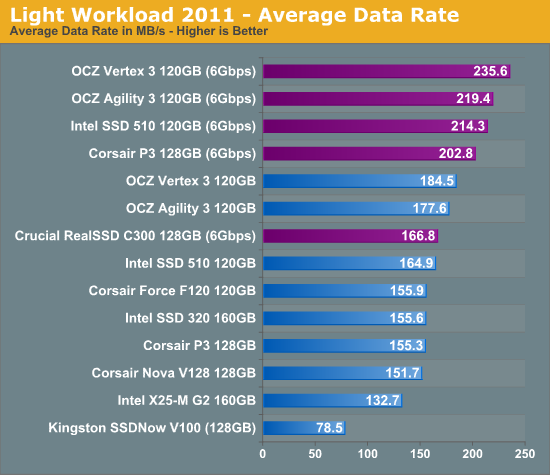
Under more typical desktop usage models the Vertex 3 is the fastest, but not by a huge margin. The Agility 3 and Intel SSD 510 are both within 10%. The major advantage for OCZ here is in read performance, which is what you do most of the time with a desktop (non-file archival) workload:
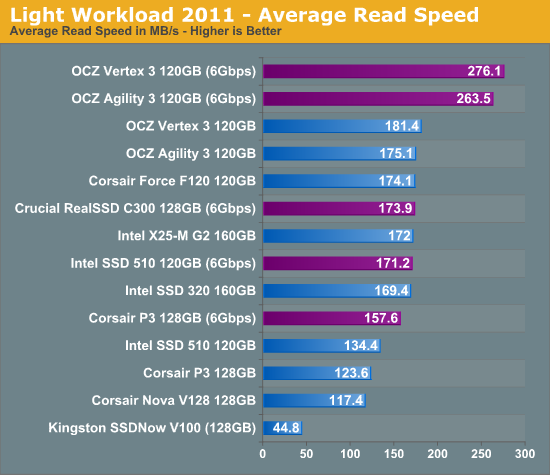
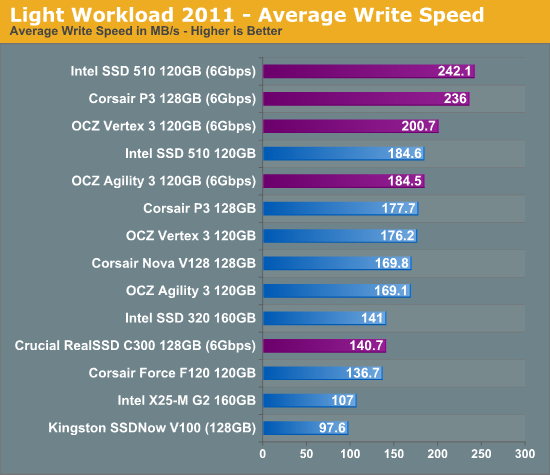
Write performance is clearly not one of the Vertex 3's strong points, at least compared to the 510 and Corsair P3 - both of which deliver top notch performance here. Despite using identical controllers, there is a tangible performance difference between these two drives.
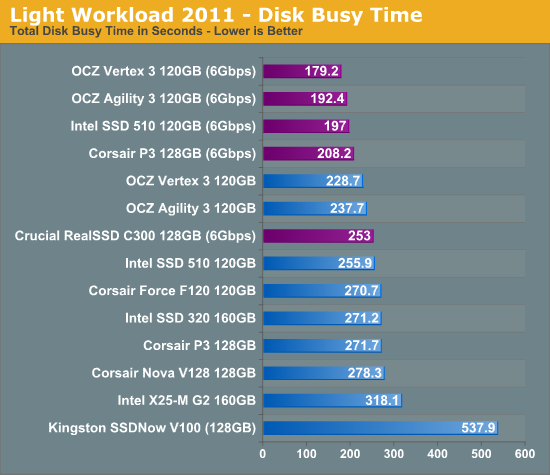
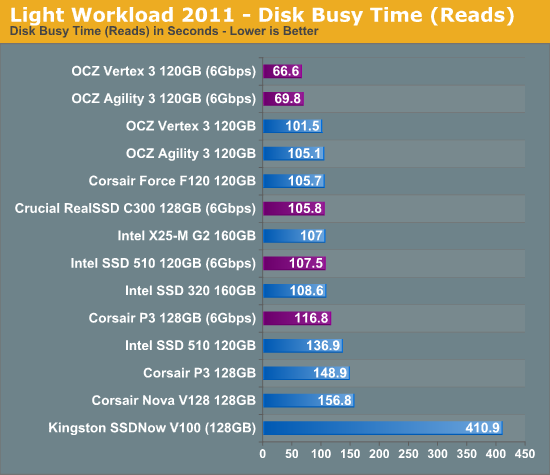
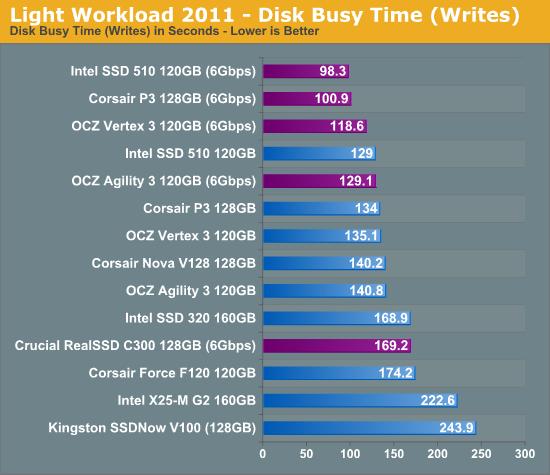










68 Comments
View All Comments
Oxford Guy - Thursday, June 9, 2011 - link
And so the 240 GB Vertex 2 would be nice to see in a review -- for perspective.jjj - Tuesday, June 7, 2011 - link
without the M4 and the MAX IOPS the comparisson is pointelss since those 2 models are the most interesting on the market atm at 120GB.dcuccia1 - Tuesday, June 7, 2011 - link
This is fantastic, thanks for the roundup. I'd love to see the same analysis at the low-end. When I build my or mom a PC with a 64GB SSD drive, I have no firm grasp on which generation of drives have the best value for a mom-style workload (word processing, music, videos, etc).SmCaudata - Tuesday, June 7, 2011 - link
Anything you can find.I have a first gen vertex 60gb that I got for $89 or something on sale before the Vertex2 drives came out. Even coming from a 1gb samsung F3 it was night and day. Outlook opens instantly and that is by far the most data intensive of the general use/productivity programs. I'm guessing music and videos will be on a separate drive anyway due to size and they play back at a fixed speed regardless so a spindle drive is just as fast for them.
So again, in summary... anything from a reputable vendor is likely going to be night and day. If you can pick up an Intel for reliability that would be a good way to go. There are some firmware issues with the c300 drives that have the potential to make them really slow, but I'm not familiar with them so I cannot speak to the specifics.
dcuccia - Wednesday, June 8, 2011 - link
Thanks, good points all around. Still, would be cool to see which drives gave a good bang for the buck for light workload systems. But you're right, at the right price it would be hard to go wrong with an old Vertex or Intel.Mr Perfect - Tuesday, June 7, 2011 - link
I'm also interested in how 64GB drives would scale, but only because they are the largest drives Intel will let you use for SSD caching. That would be completely different benchmark runs though...tecsi - Friday, July 8, 2011 - link
Yes, I have exactly the same question. What about boot/app desktop SSDs in the 40-100GB range (<$100)?Quizzical - Tuesday, June 7, 2011 - link
Are you sure that the Crucial RealSSD C300 only has 111.8 GB of usable capacity? Last July, you said that exactly the same SSD had 119.2 GB. I have the "64 GB" version of the same drive, and Windows reads it as 59.5 GB of usable capacity, so I'd expect the "128 GB" version to be around 119 GB.I don't have one, but Legit Reviews also shows the Corsair Performance 3 as having 119 GB of usable capacity, not 111.8 GB. In the past, Corsair has been inclined to do the usual hard drive manufacturer shenanigans of claiming 1 billion bytes as 1 GB, but not going beyond that and listing the total NAND flash. See the F115, which gives you about 115 billion bytes of capacity, but isn't marketed as a 128 GB drive, in spite of 128 GB of NAND flash.
Anand Lal Shimpi - Tuesday, June 7, 2011 - link
You're very correct, fixed :)Tommyv2 - Tuesday, June 7, 2011 - link
Should've waiting until you had the 120GB m4 and the 120GB Max IOPs units for review, especially with some other sites showing that the 120GB m4 actually beats out the 240GB unit in some benchmarks! Those are the two I'm most interested in, and yet there are too few reviews out there for them...